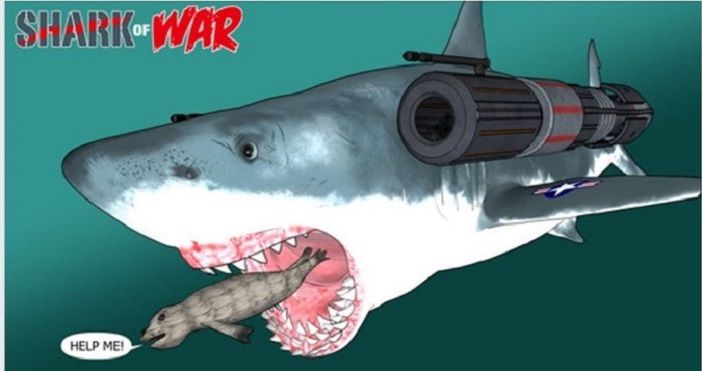
 First Comics News: How did you start your career in the comic book field?
First Comics News: How did you start your career in the comic book field?
Ben Lacy: I’ve been writing prose fiction off and on for 30 years, but I’ve always wanted to write a comic book. At the time though, I didn’t know any artists, but I happened upon a computer program that could help you make images using 3D models. As an engineer, I work a lot with computer modeling software, so I took to it pretty well. I wanted the artwork to have a more comic book look though, so I figured out a way to transform the 3D type graphics into a more traditional comic book image. One of the extras in the digital edition is a feature explaining how I make the art in the book and providing some tips for those who’d like to make their own art.
1st: How is the shark in “Shark of War” considered a hero?
Ben: USS Gnasher (as the military have dubbed him) is a reluctant hero. He’d rather use his new abilities to hunt for food, which he does at one point in the book to spectacular effect, and stay far away from humans. But an artificial intelligence, programmed with a series of military orders, has been implanted in him, and it keeps telling him to enforce the laws of the United States. He does so as a shark would, by eating the bad guys. So far though, he’s only eaten bad guys and after some hesitation, even saves one of their victims.
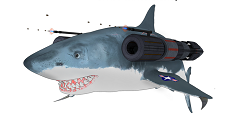 1st: How well armed is this shark?
1st: How well armed is this shark?
Ben: Gnasher has two 30 caliber automatic rifles mounted to his jet engines. He has retractable titanium claws attached to his pectoral fins and his teeth have been plated in a super tough nickel-chromium alloy that let him bite through steel. His skin was peeled off to place a titanium skeleton covered in Kevlar around him. It was then soaked in a tough polymer and reattached to him. He is bulletproof against anything smaller than a 50 caliber rifle.
Rich: What is the origin of the shark?
Ben: Looking for a meal, Gnasher was following a cruise ship dumping garbage. He got too close and was sucked into one of the ship’s propeller blades, which sliced a huge tear along his spine. A US Navy ship found him near death and brought him to a secret facility looking into the military applications of marine animals.
1st: Can you describe the scientist who created the shark?
Ben: There are two scientists primarily involved in creating Gnasher. Dr. Raye Fischer is a brilliant computer scientist and bioengineer. He’s devised a way to integrate an artificial intelligence with an organic brain. Combining that with cloned brain tissue to increase a shark’s natural intelligence, he hopes to create the first aquatic super-soldier. However, he’s also absolutely amoral. He’s killed at least 25 sharks in a horrible and painful manner trying to make the technology work. He brings in Dr. Brooke Douglas, a pioneering neurosurgeon, in the hope that she can do the needed operations without killing Gnasher. She’s at least as amoral as Fischer though, and when the project runs into problems, they both blame each other. The fallout from this allows Gnasher to escape.
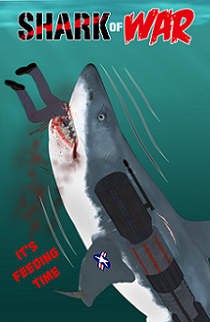 1st: What is the mob’s involvement in the story?
1st: What is the mob’s involvement in the story?
Ben: When he gets free and starts enforcing US law, Gnasher strikes at mob smuggling operations along the Gulf of Mexico and the Caribbean. Frustrated, the powerful Coastal Cartel sets a trap for him. When that fails, they hire one of his creators to make even more dangerous creatures.
1st: What type of threats will the shark face?
Ben: The biggest threat is a surprise reveal, but let’s say it’s pretty monstrous. Otherwise, his enemies are heavily armed humans as well as his creators.
1st: How intelligent is USS Gnasher and can he think for himself?
Ben: On an IQ test, Gnasher would probably test in the normal range of human intelligence. But his enhanced brain is a shark’s brain and his thought processes and focus are very different than ours. Also, he’s only now capable of having higher-level emotions, so he’s still discovering his feelings. In a later book, after being hurt badly, Gnasher will start to learn about anger and hatred.
He can think for himself, but the artificial intelligence embedded in him is also trying to influence his actions. To some degree, they have a symbiotic relationship, and at other times, they’re at odds over what to do.
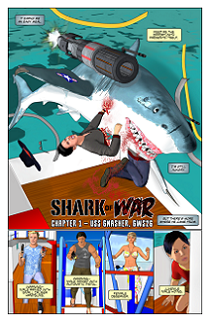 1st: Would you ride USS Gnasher if you could?
1st: Would you ride USS Gnasher if you could?
Ben: Only in the greatest emergency (which happens in the book). While one of his primary orders is to protect US citizens, like any large, powerful creature, he could easily hurt you without meaning too.
1st: Which animal land or water is best suited to be weaponized besides a shark?
Ben: Given the extra weight in weapons and armor, the bigger the better, so whales, grizzly bears, and elephants would make a lot of sense. But of course, the animal that makes the most sense is humans. We’re already capable of using tools and can think independently. Beyond the premise, one of the things I hope to touch on in the book is the integration of shark (or human) brains with computer intelligence. A lot of science fiction focuses on AI taking over, but I think it’s just as likely we start bonding ourselves ever closer with the AI, enhancing our own capabilities. You can already see that as a logical next step as we go from computers to smartphones, to smartwatches, to smart glasses, and so on.
1st: Do you think it is possible in the real world to create a shark as in “Shark of War”?
Ben: A lot of the tech concepts in Shark of War are somewhat feasible, and occasionally you read about efforts to use sharks or dolphins in military applications. I do think the actual brain modifications are a long way away and of course, attempting to do them on a living creature would be terribly immoral.
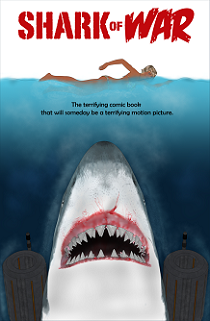 1st: How has being an engineer helped you in writing comics?
1st: How has being an engineer helped you in writing comics?
Ben: When I came up with the idea, one thing I wanted to make clear would be that when Gnasher eats his foes, he converts them into the fuel that powers his jet engines. I’ve worked in power industries for 30 years and modifying fuels from one use to another is something we work on a lot, so I came up with a theory of how this would work. One of the bonus features in the digital edition is on The Science of the Shark of War where I explain how Gnasher’s food is turned into fuel.
1st: What type of sea creature are you most like?
Ben: Hmm, I’ve never really thought about that before. Probably the sea otter. They’re like the engineers of the ocean with their ability to use simple tools to find food.
1st: What would you like to say to fans of your comic?
Ben: Shark of War may be one of the few times that a shark has been portrayed not just as the protagonist but as the hero. I think as much fun as movies like Jaws, the Meg, and Sharknado are, they’ve contributed to a view of sharks which has had actual negative consequences for how we’ve treated them. In this new millennium, it’s time to recognize the shark not as a monster or enemy, but as one of nature’s awesomest, most inspiring creatures.
Shark of War is planned as a five-issue series that should be a lot of fun for both shark fans and superhero fans. Please reserve your copy at www.SharkofWar.BitingComics.Com.
Richard Vasseur
